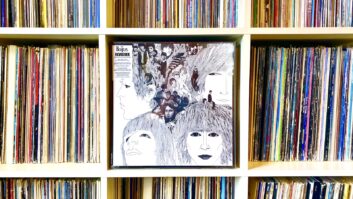Ye olde saw about wedding accoutrements, “something old, something new…” loosely fits our theme this month. Not that I’m planning on tying the knot. I’m just grooving on some things for your facility that could make life better.
First the old thing: You already know about extensions for your keyboard, monitor and mouse to keep the acoustic noise bottled up somewhere, anywhere, as long as it’s not in the control room. If you’re lucky enough to have a machine room adjacent to the control room, you can simply use good-quality, low-capacitance cable. For example, Alpha, Belden and Gepco sell triple and quad minico-ax for your RGB analog video and separate low-cap twisted pairs for your keyboard and mouse. If the piney smell of solder makes you queasy, then Network Technologies can fix you up with a clean, prefab job that will set you back only $110 for a 50-foot run. And, they have passive cable assemblies that go out to 100 feet.
But hey, what about my 50-meter run down to the spare bathroom where I keep my CPU? A passive extender won’t cut it there, Bucko. You need an active answer to your KVM cravings. KVM stands for “keyboard, video and mouse,” and there are several devices that take an active approach to “remoting” your computer. Most audio geeks would go for one of Gefen’s solutions because that’s all they know. But, we can borrow KVM concepts from pocket-protected Information Techs. KVM switches provide a one-to-many connection, allowing you to park your butt in the control room’s sweet spot and control multiple “servers” or CPUs. If you don’t need the switching capability, you can simply extend your KVM connection and leave the other server port unused until needed.
Everyone needs Category 5 wiring for general networking. So, given a run of CAT5 cable and a KVM switch, you can purchase two- or four-server, single-console KVM switch versions that let you handle several CPUs from your favorite perch. Providing extension as far as 600 feet, the price jumps up from the passive solution into the $1,000 to $2,000 range.
Competition often leads to consolidation or cooperation. Is your facility partnering (No. 1 doofy gerund of the last millennium) with some local vidiots to better serve your local market without duplicating facilities? Hmm, I thought so. Well, wouldn’t it be nice to connect your LANs, instead of sneakernetting, while maintaining control over access and permissions? Uh-huh. Would be nice, huh?
This leads us to our next topic… Something new that you may not be aware of, unless you’ve had a car fire recently, is a firewall. Firewalls are products that confine network traffic to predetermined pathways, keeping hackers out of your LAN while allowing bidirectional traffic that originates from your local network to pass unimpeded.
They used to be fancy software packages, running on big iron and requiring a team of IT dudes to keep it all together. In 1996, appliance-level devices began appearing from vendors like Netopia, providing inexpensive Internet service, via ISDN, for small office environments. Had one, loved it. The need for cost-effective, high-speed Internet connections has ballooned considerably and, with the acceptance of xDSL for home and business, the range of offerings has increased in kind.
Today, Netopia is one of many companies selling DSL routers with built-in firewalls. Inexpensive, fairly easy-to-configure firewall appliances, known as “personal firewalls,” have also appeared to address Internet security issues, especially those stemming from DSL’s inherent lack of security protocols. For less than $200, you can pick up an “Internet sharing device” that allows multiple LAN clients to use one dial-up account and V90 modem. Perfect for the one- or two-person office. Another option for you home studio types is Open Door Networks’ DoorStop software firewall for Mac OS, starting at $60. For personal firewall, antiviral detection and network filtering in one software product, Intego sells packages for Mac OS starting at $150. Network Associates, makers of Virex and Pretty Good Privacy freeware, also sells cost-effective VPN (see box on page 106) and firewall software for NT and UNIX.
For $300, you can grab a hardware hub from Dr. Bott to expand a DSL modem’s access to your whole in-house tribe. It lacks full-blown firewall services, but you can’t beat the price. For $400 to $800, you can get a full-featured, expandable hub from WatchGuard Technologies.
Finally, the blue item, ’cause I couldn’t find anything borrowed. That would be the “Cocktail Blue” SM-SX100, the most interesting thing I witnessed at Winter CES. (By the way, the second most important happening was when Philips showed that a DVD+RW disc created in its prototype DVD-V recorder would play in consumer DVD-V players. Fascinating, Captain.)
Sorry, back to the SM-SX100. At the LVCC, along with the 1394 Trade Association (which I’ll get to after the developer’s conference), home networking booths and Taser International, makers of Electro-Muscular Disruptors (won’t be going there, sorry), was the large, retro spread of Sharp Electronics Corporation. Tasteful dioramas of lifestyle products, humongous TVs, your basic cool CE gear. Ah, but hiding in a niche, all by itself, was a strange, dare I say, homely critter that caught my attention. The front panel said “1-bit amplifier,” which in and of itself is no big thing. Your basic “digital” power amp is fairly common these days, this one being 100 watts stereo into 8 ohms. But the back panel possessed the high groove factor-connectors labeled “SACD.” Yup, DSD inputs presumably being fed from the forthcoming companion SX-DX1 SACD player shipping in August. A baby version, the SM-SX1 50-watt, 1-bit amp, will also ship along with the player. Both the SM-SX100 and SM-SX1 have the proprietary 13-pin connection on the back for direct bitstream coupling of the SX-DX1 player to either amplifier.
No matter what you may think about SACD as a distribution format, one listen to a live performance skillfully recorded on DSD should convince you of the merits of the underlying technology. Then again, have you had your hearing tested lately? Oops, we won’t go there either.
So, old and new, borrowed and blue (and chrome). Stuff to make your facility more ergonomic and more secure. As usual, keep the e-cards and letters comin’, and stop by the site for links to all the companies mentioned and a good bit more.
NAB SUES RIAA OVER WEB BROADCAST ROYALTIESIn March, the National Association of Broadcasters sued the Recording Industry Association of America (RIAA) in an attempt to block the group from charging royalties to radio stations that also broadcast online. The RIAA claims that Internet radio stations and on-air stations that Webcast are both required to pay royalties, according to the Digital Millennium Copyright Act passed in 1998. Broadcasters counter that they are already paying performance rights agencies, and that historically, radio stations have been exempt from paying royalties to record labels, and that this law extends to Internet broadcasters. The RIAA says that these royalties now pertain to sound recordings, rather than public performances of song compositions and lyrics (which are paid to ASCAP and BMI). The claim was filed with the U.S. District Court in New York.
PLUG.IN NEXT MONTHThe fifth annual Plug.In: the Jupiter Online Music Forum will take place next month, from July 24-25, at the Sheraton Hotel and Towers in New York City. The event, which focuses on the future of the music on the Internet, features seminars, workshops and a technology showcase; visit www.australia.jup.com/jupiter/events for details.




